Health
Disco Felon
A "disco felon" is a medical condition caused by snapping one's fingers too much to disco music. It was first reported in the New England Journal of Medicine.The original article is behind a paywall, but Edward Nash provided some details in the journal Science Year 1982:
The doctors treated the girl by draining and bandaging the inflammation. She recovered, but Walker and his associates sounded a dire warning to other disco dancers and their doctors. "Disco dancing may eventually be shown to damage a variety of body systems: namely visual, auditory, orthopedic, and nutritional. [Nutritional] damage might result from self-imposed starvation in an attempt... to wear the latest outfits."
A correspondent to the NEJM later suggested that "disco digit" might be a less confusing name for the condition.
Posted By: Alex - Tue Jul 27, 2021 -
Comments (3)
Category: Health, Music, 1970s
Dr. Somers’ Cocaine Cure for Arthritis
Back in the late 1970s, Dr. Lowell Somers, chief of staff at Redbud Community Hospital, made headlines by claiming to have discovered that cocaine could cure arthritis. Somers explained that he discovered this by observing his identical twin cousins, Chuck and Rick. Chuck had arthritis, but Rick didn't. And Rick was a cocaine user, while Chuck wasn't.Somers said he had successfully treated a dozen rheumatoid patients with cocaine. His procedure:
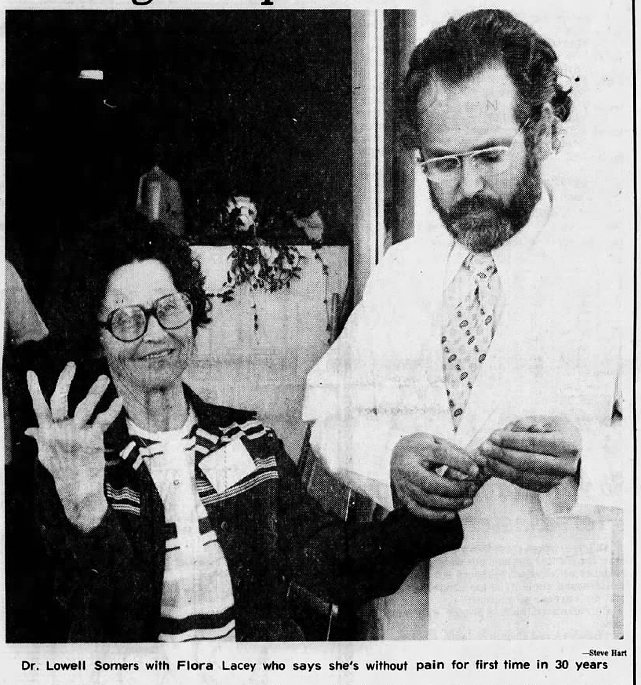
Santa Rosa Press Democrat - Apr 13, 1979
It didn't take long for authorities to shut him down, which they did by charging that he was addicted to demerol and cocaine, and revoking his medical license. I guess he was taking the cure himself. Some info from The Oklahoman:
This sidestepped the issue of whether he may actually have been right about the medical benefit of cocaine for people with arthritis. It doesn't seem entirely implausible to me.
However, some googling pulls up an article suggesting that cocaine use may actually cause rheumatologic conditions. Although the authors admit they're not sure if the cocaine is the culprit, or the contaminants in the cocaine.
On the other hand, there's quite a bit of literature about the potential medical benefits of coca leaves, which people have been consuming in South America for thousands of years. Although coca leaves are a far cry from the pure cocaine Somers was using.
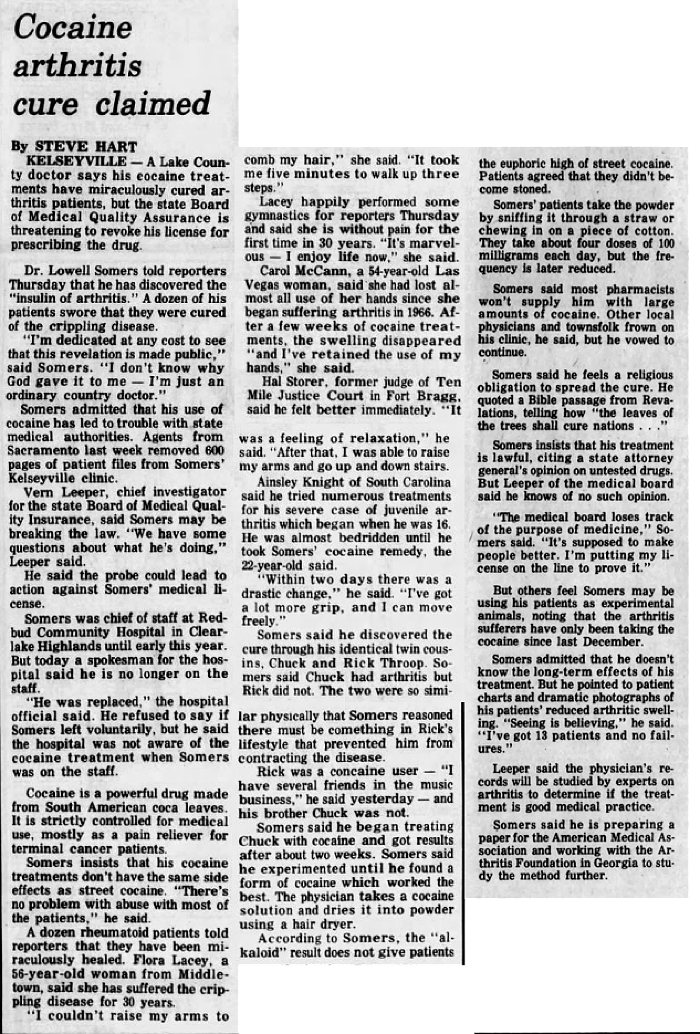
Santa Rosa Press Democrat - Apr 13, 1979
Posted By: Alex - Thu Jul 15, 2021 -
Comments (0)
Category: Drugs, Health, Medicine, 1970s
Hiccup-curing straw (and other hiccup cures)
Researchers have invented a straw that, they claim, will cure hiccups. They call it the HiccAway. From the product page: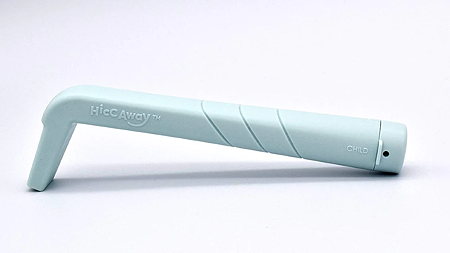
Back in 2015, we posted about Hiccupops, invented by 16-year-old Mallory Kievman. These were apple-cider lollipops that, she said, could cure hiccups. Apparently she's done well with her invention, because she's now the CEO of a company selling them.
And here's some more hiccup cures, from an article I wrote for about.com (back when the site still existed):
But in the second half of the 20th century, researchers stumbled upon some less-invasive, but definitely odd, hiccup cures.
The first of these was reported by Dr. Erminio Cardi of Rhode Island in an August 1961 issue of the New England Journal of Medicine. Dr. Cardi had discovered that he was able to cure the hiccups of several patients simply by using a cotton swab to manipulate a hair in their external ear canal. He confessed that this treatment was "seemingly unorthodox," but it worked. He theorized that it did so because the hair had been irritating a nerve that triggered the hiccup response.
And if examination of the ear revealed no hair irritant? No problem. In that case "twirl a stick tipped with cocaine-soaked cotton in the ear," instructed the doctor.
Nowadays doctors are more likely to use lidocaine than cocaine, but the principle remains the same.
The second cure is even more unorthodox, but again, it seems to work. In an August 1988 issue of the Annals of Emergency Medicine, Dr. Francis Fesmire of Jacksonville, Florida reported that a "digital rectal massage" (aka a finger up the bum) had unexpectedly cured a patient of hiccups. Fesmire didn't record what inspired him to think of this technique, but the reason why it worked, he suggested, was similar to the ear method — because it calmed an overactive nerve. Several other doctors have subsequently reported success using this technique.
Posted By: Alex - Thu Jun 24, 2021 -
Comments (4)
Category: Health
Listerine Cigarettes
Another case of an odd brand extension. In 1927, the manufacturer of Listerine debuted Listerine Cigarettes that were infused with the same antiseptic oils used in the mouthwash.The company claimed that these cigarettes would not only "soothe the delicate membranes of mouth and throat," just like the mouthwash, but also that they would "kill 200,000,000 germs in fifteen seconds" and help smokers avoid colds.
As far as I can tell, Listerine Cigarettes remained on the market until the mid-1930s and then disappeared.
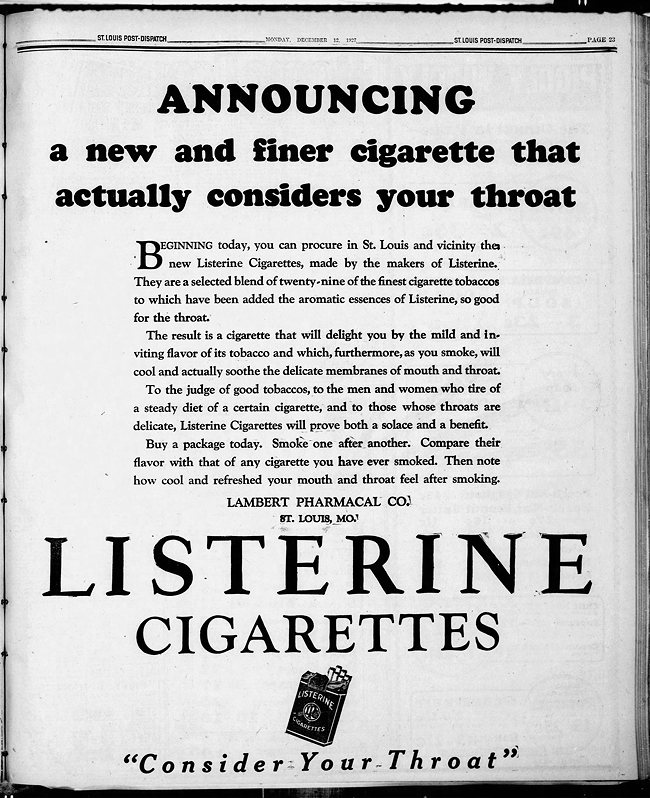
St. Louis Post-Dispatch - Dec 12, 1927
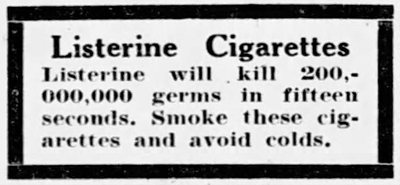
Tampa Tribune - Nov 8, 1930
Posted By: Alex - Sat Jun 19, 2021 -
Comments (5)
Category: Health, Cures for the common cold, Smoking and Tobacco
The Blanc Mask
A new face mask that not only filters air but also prevents facial recognition.More info: blancmasks.com, gizmodo


Posted By: Alex - Mon Feb 22, 2021 -
Comments (6)
Category: Fashion, Health
Donald Campbell, the man who couldn’t stop talking
In 1933, Donald Campbell, a truck driver, fell from his truck and hit his head. A year later he developed a bizarre condition. He started talking incessantly, non-stop. His talking was so compulsive that he couldn't even sleep. His talking was perfectly rational. He answered questions clearly. But he couldn't stop.Doctors attributed his condition to encephalitis, or brain swelling. After about a month his non-stop talking subsided, and doctors thought he had recovered. But within four months he was dead. Strangely, the cause of his death was cancer and seemed to be unrelated to his non-stop talking.
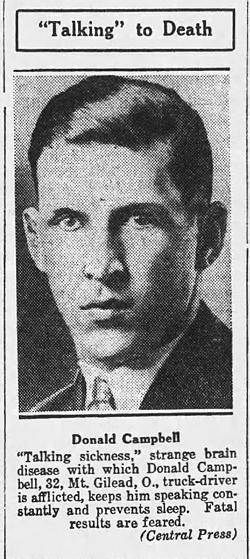
Pottsville Evening Herald - Aug 17, 1934
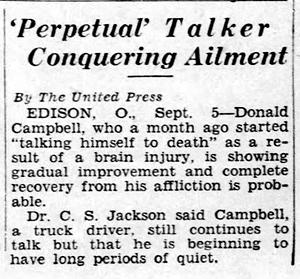
Pittsburgh Press - Sep 5, 1934
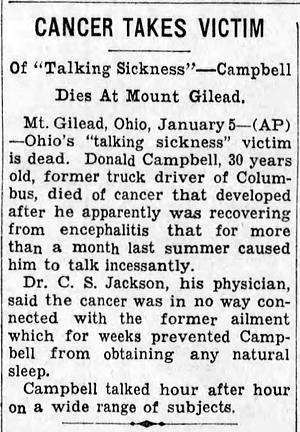
Cincinnati Enquirer - Jan 6, 1935
Update — A newspaper recorded an example of some of Campbell's rambling monologue:
Posted By: Alex - Thu Jan 07, 2021 -
Comments (4)
Category: Health, Mental Health and Insanity, 1930s
Hearing music while checking a pulse
According to a recent report in the New England Journal of Medicine, when hospital workers in Southern California used a handheld Doppler device to check the pulse of a 65-year-old man who had recently had both hips replaced, they heard music. Other Doppler devices also picked up music seeming to come from inside the man. However, they didn't hear music from any other patients. The doctors concluded that the man's prosthetic hips were picking up a radio station.LiveScience.com has identified the song his hips were playing as "Gracias Por Tu Amor" by Banda El Recodo De Cruz Lizarraga.
Posted By: Alex - Sat Dec 26, 2020 -
Comments (3)
Category: Health, Music, Skulls, Bones and Skeletons
Kent, the asbestos-filtered cigarette
In 1952, in response to growing concerns about the safety of cigarettes, the Lorillard Tobacco Company introduced Kent cigarettes, boasting that they contained a "Micronite filter" developed by "researchers in atomic energy plants".Turned out that the key ingredient in the Micronite filter was asbestos. From wikipedia:
According to Mother Jones, the company is still battling lawsuits to this day.

Chicago Tribune - Apr 1, 1952
Posted By: Alex - Mon Dec 14, 2020 -
Comments (1)
Category: Health, Atomic Power and Other Nuclear Matters, Smoking and Tobacco, 1950s
Chlorine gas cures colds
During the 1920s, chlorine gas (the same stuff used as a chemical weapon in World War I) briefly became popular as a cure for the common cold.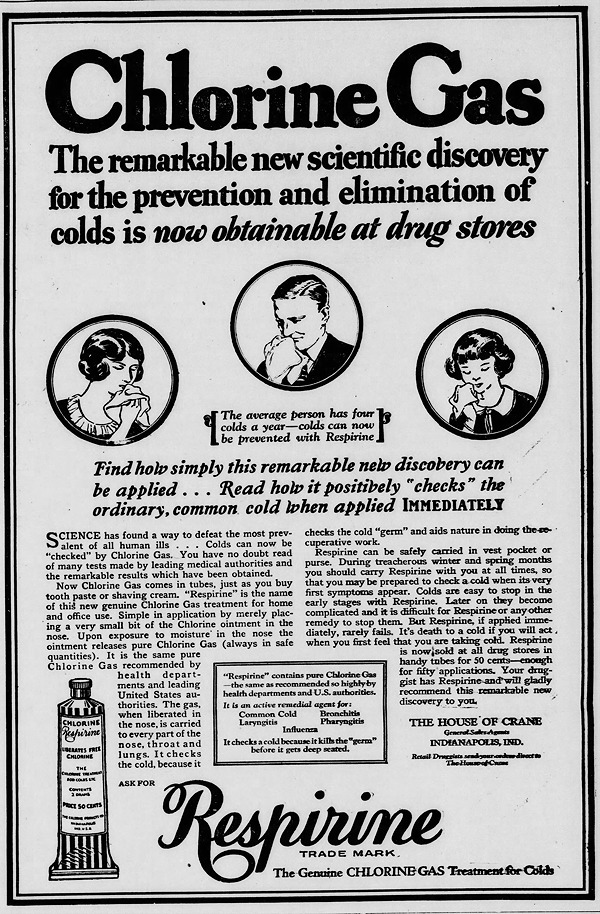
The Rushville Daily Republican - Mar 26, 1926
Jennifer Ackerman explains what was going on in her book Ah-Choo! The Uncommon Life of Your Common Cold:
Chlorine was thought to act as a kind of thorn-in-the-flesh therapy. Vedder (dubbed "the chemical warrior" by Time magazine) proposed that "the irritant action of chlorine stimulates the flow of secretion and cleanses the mucous surfaces," resulting in "productive coughing and blowing of the nose." Through its oxidizing action, the gas was also thought to rid the body of toxins and fuel the activity of white blood cells useful in the attack against offending microbes.
Practically overnight, chlorine therapy became a popular treatment for victims of colds, bronchitis, and whooping cough... For the general public, there was Chlorine Respirine, 50 treatments for $0.50 in a handy collapsible tube, each dose purported to "knock a cold in three hours."
Controlled experiments eventually debunked the idea that chlorine gas had any curative value. Though I'm not sure how to explain why people exposed to chlorine didn't seem to catch colds as often. Perhaps it was just mistaken, anecdotal evidence. Or perhaps the chlorine gas was sterilizing surfaces, helping to prevent the transmission of germs.
Posted By: Alex - Fri Nov 20, 2020 -
Comments (1)
Category: Health, Patent Medicines, Nostrums and Snake Oil, Cures for the common cold, 1920s
Germs pick out the weak ones
The theme of this 1920's ad campaign was that if your kid didn't eat Ralston Purina breakfast cereal, then he/she was going to die.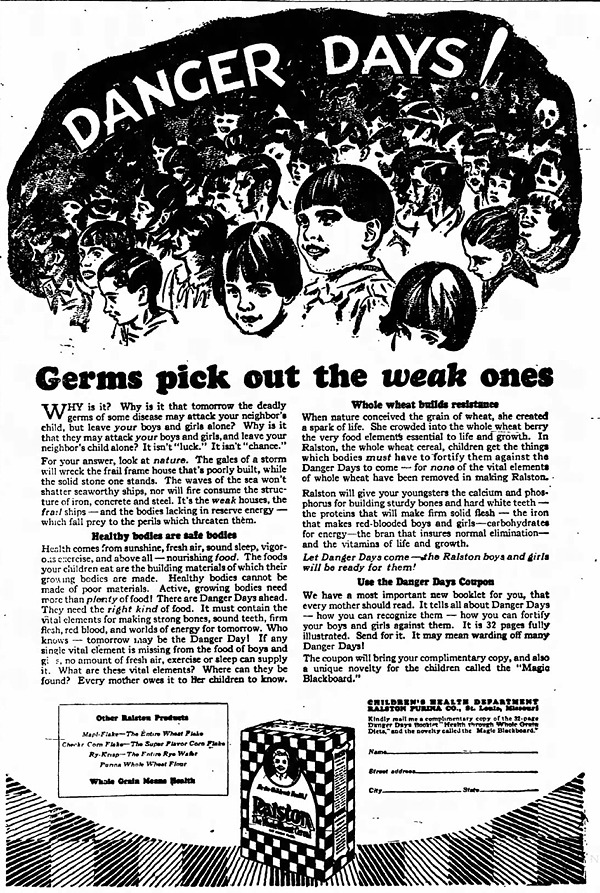
Fitchburg Sentinel - Jan 3, 1928
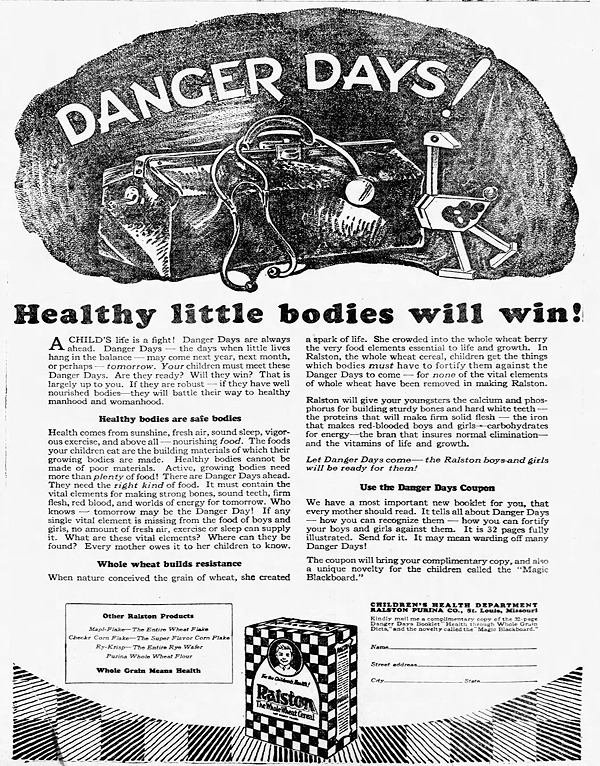
Pittsburgh Press - Nov 1, 1927
Posted By: Alex - Thu Nov 19, 2020 -
Comments (2)
Category: Health, Advertising, Cereal, 1920s

| Who We Are |
|---|
| Alex Boese Alex is the creator and curator of the Museum of Hoaxes. He's also the author of various weird, non-fiction, science-themed books such as Elephants on Acid and Psychedelic Apes. Paul Di Filippo Paul has been paid to put weird ideas into fictional form for over thirty years, in his career as a noted science fiction writer. He has recently begun blogging on many curious topics with three fellow writers at The Inferior 4+1. Contact Us |




